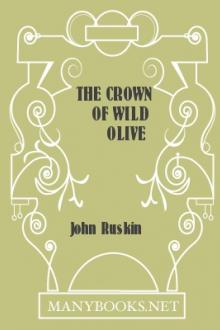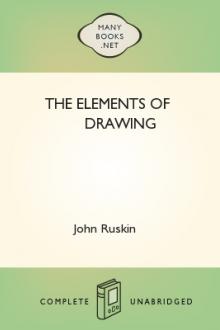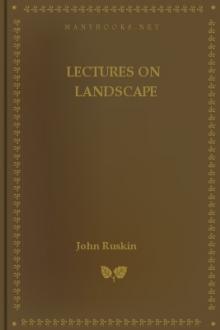The Crown of Wild Olive by John Ruskin (a court of thorns and roses ebook free .TXT) 📕

- Author: John Ruskin
- Performer: -
Book online «The Crown of Wild Olive by John Ruskin (a court of thorns and roses ebook free .TXT) 📕». Author John Ruskin
You think, perhaps, I am quitting my subject, and proceeding, as it is too often with appearance of justice alleged against me, into irrelevant matter. Pardon me; the end, not only of these lectures, but of my whole professorship, would be accomplished,—and far more than that,—if only the English nation could be made to understand that the beauty which is indeed to be a joy for ever, must be a joy for all; and that though the idolatry may not have been wholly divine which sculptured gods, the idolatry is wholly diabolic, which, for vulgar display, sculptures diamonds.
18. To go back to the point under discussion. A pearl, or a glass bead, may owe its pleasantness in some degree to its lustre as well as to its roundness. But a mere and simple ball of unpolished stone is enough for sculpturesque value. You may have noticed that the quatrefoil used in the Ducal Palace of Venice owes its complete loveliness in distant effect to the finishing of its cusps. The extremity of the cusp is a mere ball of Istrian marble; and consider how subtle the faculty of sight must be, since it recognizes at any distance, and is gratified by, the mystery of the termination of cusp obtained by the gradated light on the ball.
In that Venetian tracery this simplest element of sculptured form is used sparingly, as the most precious that can be employed to finish the façade. But alike in our own, and the French, central Gothic, the ball-flower is lavished on every line—and in your St. Mary's spire, and the Salisbury spire, and the towers of Notre Dame of Paris, the rich pleasantness of decoration,—indeed, their so-called "decorated style,"—consists only in being daintily beset with stone balls. It is true the balls are modified into dim likeness of flowers; but do you trace the resemblance to the rose in their distant, which is their intended effect?
19. But farther, let the ball have motion; then the form it generates will be that of a cylinder. You have, perhaps, thought that pure Early English Architecture depended for its charm on visibility of construction. It depends for its charm altogether on the abstract harmony of groups of cylinders,[111] arbitrarily bent into mouldings, and arbitrarily associated as shafts, having no real relation to construction whatsoever, and a theoretical relation so subtle that none of us had seen it, till Professor Willis worked it out for us.
20. And now, proceeding to analysis of higher sculpture, you may have observed the importance I have attached to the porch of San Zenone, at Verona, by making it, among your standards, the first of the group which is to illustrate the system of sculpture and architecture founded on faith in a future life. That porch, fortunately represented in the photograph, from which Plate I. has been engraved, under a clear and pleasant light, furnishes you with examples of sculpture of every kind from the flattest incised bas-relief to solid statues, both in marble and bronze. And the two points I have been pressing upon you are conclusively exhibited here, namely,—(1). That sculpture is essentially the production of a pleasant bossiness or roundness of surface; (2) that the pleasantness of that bossy condition to the eye is irrespective of imitation on one side, and of structure on the other.
21. (1.) Sculpture is essentially the production of a pleasant bossiness or roundness of surface.
If you look from some distance at these two engravings of Greek coins, (place the book open so that you can see the opposite plate three or four yards off,) you will find the relief on each of them simplifies itself into a pearl-like portion of a sphere, with exquisitely gradated light on its surface. When you look at them nearer, you will see that each smaller portion into which they are divided—cheek, or brow, or leaf, or tress of hair—resolves itself also into a rounded or undulated surface, pleasant by gradation of light. Every several surface is delightful in itself, as a shell, or a tuft of rounded moss, or the bossy masses of distant forest would be. That these intricately modulated masses present some resemblance to a girl's face, such as the Syracusans imagined that of the water-goddess Arethusa, is entirely a secondary matter; the primary condition is that the masses shall be beautifully rounded, and disposed with due discretion and order.
22. (2.) It is difficult for you, at first, to feel this order and beauty of surface, apart from the imitation. But you can see there is a pretty disposition of, and relation between, the projections of a fir-cone, though the studded spiral imitates nothing. Order exactly the same in kind, only much more complex; and an abstract beauty of surface rendered definite by increase and decline of light—(for every curve of surface has its own luminous law, and the light and shade on a parabolic solid differs, specifically, from that on an elliptical or spherical one)—it is the essential business of the sculptor to obtain; as it is the essential business of a painter to get good colour, whether he imitates anything or not. At a distance from the picture, or carving, where the things represented become absolutely unintelligible, we must yet be able to say, at a glance, "That is good painting, or good carving."
And you will be surprised to find, when you try the experiment, how much the eye must instinctively judge in this manner. Take the front of San Zenone for instance, Plate I. You will find it impossible without a lens, to distinguish in the bronze gates, and in great part of the wall, anything that their bosses represent. You cannot tell whether the sculpture is of men, animals, or trees; only you feel it to be composed of pleasant projecting masses; you acknowledge that both gates and wall are, somehow, delightfully roughened; and only afterwards, by slow degrees, can you make out what this roughness means; nay, though here (Plate III.) I magnify[112] one of the bronze plates of the gate to a scale, which gives you the same advantage as if you saw it quite close, in the reality,—you may still be obliged to me for the information, that this boss represents the Madonna asleep in her little bed, and this smaller boss, the Infant Christ in His; and this at the top, a cloud with an angel coming out of it, and these jagged bosses, two of the Three Kings, with their crowns on, looking up to the star, (which is intelligible enough I admit); but what this straggling, three-legged boss beneath signifies, I suppose neither you nor I can tell, unless it be the shepherd's dog, who has come suddenly upon the Kings with their crowns on, and is greatly startled at them.
23. Farther, and much more definitely, the pleasantness of the surface decoration is independent of structure; that is to say, of any architectural requirement of stability. The greater part of the sculpture here is exclusively ornamentation of a flat wall, or of door panelling; only a small portion of the church front is thus treated, and the sculpture has no more to do with the form of the building than a piece of a lace veil would have, suspended beside its gates on a festal day; the proportions of shaft and arch might be altered in a hundred different ways, without diminishing their stability; and the pillars would stand more safely on the ground than on the backs of these carved animals.
24. I wish you especially to notice these points, because the false theory that ornamentation should be merely decorated structure is so pretty and plausible, that it is likely to take away your attention from the far more important abstract conditions of design. Structure should never be contradicted, and in the best buildings it is pleasantly exhibited and enforced; in this very porch the joints of every stone are visible, and you will find me in the Fifth Lecture insisting on this clearness of its anatomy as a merit; yet so independent is the mechanical structure of the true design, that when I begin my Lectures on Architecture, the first building I shall give you as a standard will be one in which the structure is wholly concealed. It will be the Baptistry of Florence, which is, in reality, as much a buttressed chapel with a vaulted roof, as the Chapter House of York—but round it, in order to conceal that buttressed structure, (not to decorate, observe, but to conceal) a flat external wall is raised; simplifying the whole to a mere hexagonal box, like a wooden piece of Tunbridge ware, on the surface of which the eye and intellect are to be interested by the relations of dimension and curve between pieces of encrusting marble of different colours, which have no more to do with the real make of the building than the diaper of a Harlequin's jacket has to do with his bones.
25. The sense of abstract proportion, on which the enjoyment of such a piece of art entirely depends, is one of the æsthetic faculties which nothing can develop but time and education. It belongs only to highly-trained nations; and, among them, to their most strictly refined classes, though the germs of it are found, as part of their innate power, in every people capable of art. It has for the most part vanished at present from the English mind, in consequence of our eager desire for excitement, and for the kind of splendour that exhibits wealth, careless of dignity; so that, I suppose, there are very few now even of our best-trained Londoners who know the difference between the design of Whitehall and that of any modern club-house in Pall-mall. The order and harmony which, in his enthusiastic account of the Theatre of Epidaurus, Pausanias insists on before beauty, can only be recognized by stern order and harmony in our daily lives; and the perception of them is as little to be compelled, or taught suddenly, as the laws of still finer choice in the conception of dramatic incident which regulate poetic sculpture.
26. And now, at last, I think, we can sketch out the subject before us in a clear light. We have a structural art, divine, and human, of which the investigation comes under the general term, Anatomy; whether the junctions or joints be in mountains, or in branches of trees, or in buildings, or in bones of animals. We have next a musical art, falling into two distinct divisions—one using colours, the other masses, for its elements of composition; lastly, we have an imitative art, concerned with the representation of the outward appearances of things.





Comments (0)